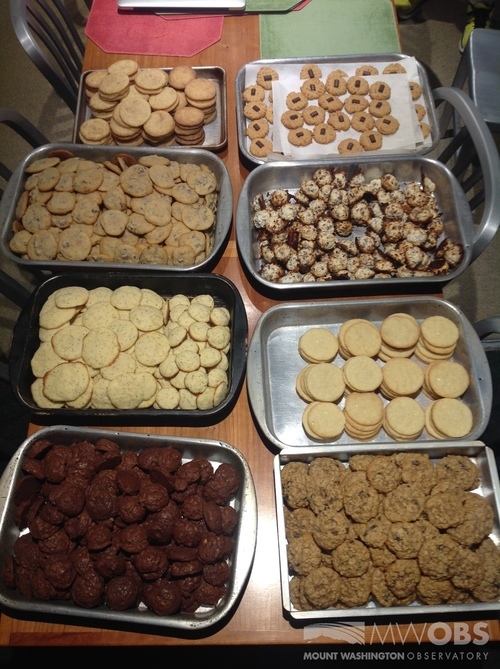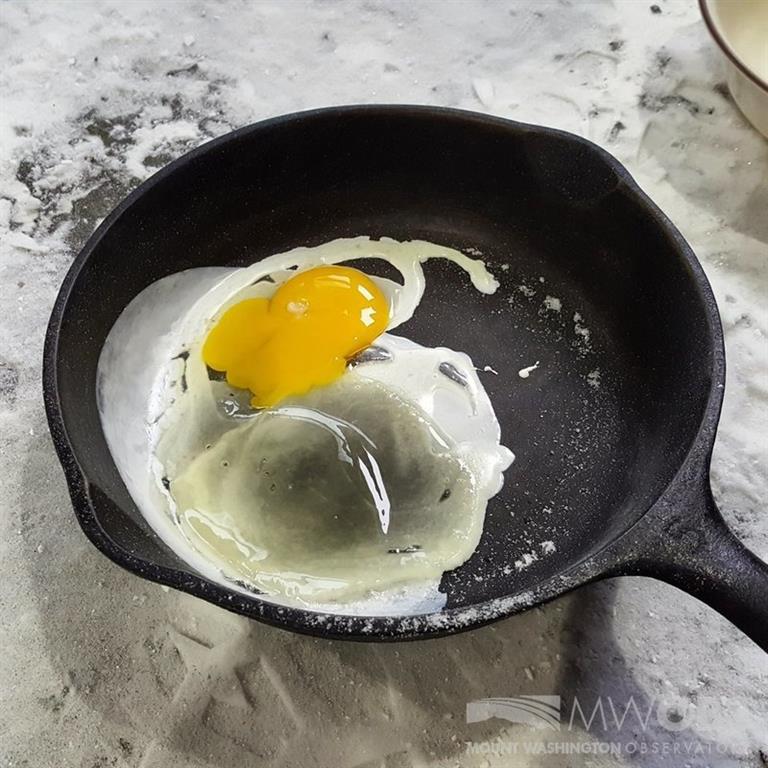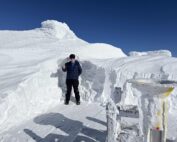Cooking at Altitude: It’s a Piece of Cake!
2017-09-28 14:33:21.000 – Taylor Regan, Weather Observer
Working at a fully manned mountaintop weather station definitely has its challenges…did you know that one of them is cooking? Located at 6,288 feet above sea level, the Mount Washington Observatory is well above the “high altitude” threshold, which most cookbooks consider to be 3,000-3,500 feet. You’ve probably seen “high-altitude” baking instructions on the back of some ready-made mixes, but why exactly do ingredient amounts and baking times change?
I’m so glad you asked! As someone who enjoys cooking, I was intrigued by not only the required changes to recipes based on altitude, but also, why those changes had to be made. The main factor is air pressure. As you climb higher in elevation, you move upwards through the atmosphere. With less air above you, pushing down, the air pressure is reduced, and it continues to decrease the higher you venture! Baking is most susceptible to changes in altitude, because it relies on the complex interactions between flour, leavening, fats, and liquids. Some changes involve not only the time and temperature something is cooked at, but also, the amounts of each ingredient! So, how does altitude play a role?
 Figure 1. 850 Cookies baked for “Seek-the-Peak”
Figure 1. 850 Cookies baked for “Seek-the-Peak”There are three main ways that altitude begins to effect cooking, and especially, baking. Higher elevation means a lower boiling point for water, which in turn means that foods take longer to cook, and that dense or moist batter may take longer to completely cook through the middle. At sea level, water boils at 212 degrees Fahrenheit, but with every increase of about 500 feet, that boiling point drops by about 1 degree, meaning that, up at the summit here, water actually boils at around 200 degrees. Interestingly, turning up the heat will not help the food cook faster, because water in a free environment (not in a pressure cooker) can’t exceed its own boiling point! Additionally, higher elevation means that moisture evaporates more quickly. This changes the ratio of liquids to solids, which can weaken the overall structure of the dough or batter. Additionally, flavors tend to be more muted. Thirdly, an increase in altitude means that the gases which provide leavening expand more quickly (think air, carbon dioxide, water vapor). As a result, cakes tend to rise much more quickly and then sink in the center when cooling. Additionally, yeast breads are increasingly likely to over-proof, and then collapse after baking.
 Figure 2. “Freeze Frying” an egg in cold temps!
Figure 2. “Freeze Frying” an egg in cold temps!While baking is the most susceptible to changes in altitude, it is not the only cooking method that needs to be monitored. Above 3,000 feet, changes are also needed when cooking other foods, such as meats and poultry, or even spaghetti!
Did you know? One-third of the entire population of the United States lives at high altitude, so adjusting recipes to account for a decrease in air pressure is a relatively common occurrence! Waffles anyone?
Taylor Regan, Weather Observer
An Experience Worth 1,000 More
An Experience Worth 1,000 More By Mitchell Tsokatos Me and the summit sign once winter really got going. Taken 11/2/25. Unfortunately, my time on Mount Washington as an intern has come to
Supporter Spotlight: AJ Mastrangelo
Supporter Spotlight: AJ Mastrangelo By Wendy Almeida A young AJ on the summit with Rebecca Scholand. AJ Mastrangelo’s relationship with Mount Washington Observatory began long before his internship—or his current career as
Supporter Spotlight: Angelo Decrisantis
Supporter Spotlight: Angelo Decrisantis By Wendy Almeida For Angelo Decrisantis, Mount Washington has been a lifelong connection. It began in 1965, at age 15, on a family drive to the summit. “My first experience



